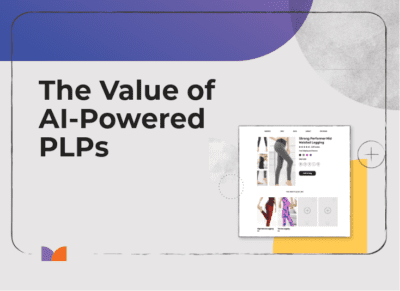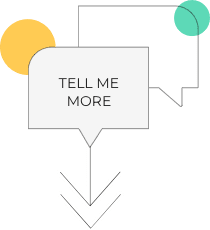
The Value of AI-Powered Product Listing Pages (PLPs)
By the time a shopper lands on your website, they’ve probably already done some research—on Google, Amazon, a social platform like Pinterest, or even a physical store. According to PwC’s 2024 Voice of the Consumer Survey, shoppers use a mix of online and offline channels to discover a product. Influences include social media, email, ads, and SMS campaigns.
Our point is this: most people are not at the top of the funnel by the time they reach one of your product listing pages (PLPs). You need to make these pages count.
Product listing pages, also called category listing pages (CLPs), are your digital shelves, the pivotal point where browsing turns into buying. When a shopper arrives at a PLP, they might be truly interested in making a purchase, but they also might be deep in the “deciding” phase of the buying journey.
The fact that shoppers are at wildly different points in their decision-making process when they arrive at a PLP is a big challenge for retailers, particularly when PLPs are the same for everyone. The best way to address this is through personalized PLPs that give each shopper a uniquely relevant digital shelf experience.
What are Product Listing Pages?
Product listing pages are exactly what they sound like: pages on your website or app that display a category of products in a grid or list format. They’re the equivalent of walking into a physical store like Target and browsing the board game aisle or dairy section of the grocery department—specific, but still broadly displaying many different products meant to appeal to all types of shoppers.
In the digital version of this in-store experience, the items on PLPs are grouped by category and meant to get prime visibility. The way they appear, including images, product descriptions, pricing, and other elements, influence what shoppers notice (and ultimately buy.)
But while shelves in the real world can’t instantly rearrange the items they contain for each customer who walks in (wouldn’t that be nice?), digital shelves can.
By using data, AI algorithms, and machine learning, modern PLPs can be personalized in real-time. They can adapt to each user based on shopper behavior, preferences, and needs.
Why Traditional PLPs Need an Upgrade
A typical online shopping experience can be frustrating, particularly when the shopper (we’ll call him Andrew) is presented with irrelevant or generic items.
Consider that Andrew is looking for a bird feeder. A static PLP might show him the same lineup of bird feeders as everyone else, whether they’re a casual backyard birder or an ornithologist. But Andrew isn’t like everyone else. He’s an ornithologist that manages a nonprofit bird sanctuary. He buys bird feeders often.
What if the category page that Andrew is browsing could recognize this, understanding that Andrew often purchases premium, squirrel-proof bird feeders—the kind that endure many different types of birds in a busy wildlife sanctuary and are typically priced in the $150+ range?
Or, maybe the website knows that Andrew has shown interest in heated bird baths. If so, the page can adjust to show similar products using a trifecta of technologies including AI, machine learning, and data.
Without this level of personalization, you’re facing a few challenges including:
- Information Overload: When shoppers face too many irrelevant options, they often leave without buying anything
- Wasted Time: Customers spend precious minutes filtering and sorting to find what they actually want
- Missed Opportunities: Retailers lose sales when shoppers can’t quickly find products that match their preferences
- Poor Experience: Static PLPs that can’t adapt to different shopping styles or customer needs fall flat when it comes to experience
Personalization creates a better experience because it turns the generic PLP that Andrew would’ve seen into a PLP featuring products tailored to him (based on data and behavior). The pages adapt in real-time within the context of the shopper and the search.
How AI Improves PLP Personalization
Monetate uses machine learning to understand what each shopper is most likely to be interested in, then automatically adjusts the product display to match. Here’s how it works:
1. Customer Affinity Data Collection
AI collects data on customer behaviors, such as browsing history, clicks, time spent on products, and previous purchases. This data is stored in a dynamic user profile.
2.Real-Time Analysis and Affinity Scoring
Machine learning models analyze this data to understand each customer’s preferences color, size, brand, or product category and assign an affinity score.
3. Dynamic Product Reranking
AI algorithms use the affinity scores to reorder products on PLPs in real time, showing customers like Andrew the most relevant items first. This could be during the same session or subsequent visits. In either case, the AI ensures every PLP reflects Andrew’s preferences.
4. Post-Session Insights
Once his session ends, AI refines Andrew’s user profiles with new data, improving personalization for future interactions and creating a consistent and seamless customer experience.
Use AI-Driven PLPs to Transform Your Bottom Line
When you personalize PLPs with AI, you’re directly impacting your business metrics. Providing tailored digital shelves helps improve your KPIs by:
1. Turning Spenders into Bigger Spenders: AOV
When shoppers like Andrew see products that match their preferences and price points, they’re more likely to add items to their cart. They also spend less time scrolling through irrelevant items (in Andrew’s case, basic $30 feeders won’t cut it), and more time viewing the items likely to meet their needs. This natural alignment between products and preferences consistently drives up average order values.
2. Keeping Shoppers Engaged: Reduced Bounce Rates
It takes about a tenth of a second for people to form a first impression on something—another person, a room layout, a product listing page. You have very little time to convince a shopper to stick around and if Andrew lands on a page full of cheap bird feeders, he’s likely to leave. But when Andrew sees exactly what he’s looking for (those premium bird feeders and heated bird baths), he stays. Personalized PLPs dramatically reduce bounce rates by showing visitors what matters to them from the start.
3. Driving Deeper Product Discovery: Engagement
Relevant products spark curiosity. When Andrew sees bird feeders that match his professional needs, he’s more likely to click through, compare options, and explore related products. This natural exploration increases meaningful engagement across your site.
4. Increasing Session Length: Increased Time on Site
Think about how long you spend in a store when everything interests you versus when you’re just not feeling it. The same principle applies online. When shoppers consistently see relevant products, they spend more time exploring your site (e.g., longer session length). More time spent often means more sales.
5. Encouraging Exploration: Increased Pages Per Session
When Andrew encounters products he likes, he’s not just motivated to stick around longer, he’s also motivated to explore. He might jump from premium feeders to specialized bird baths to professional-grade seed—all because each page shows him relevant options. This increased page exploration often leads to discovering (and purchasing) products shoppers might have otherwise missed.

The Monetate Advantage
Monetate helps retailers personalize PLPs and other experiences with features like personalized search, customized product recommendations, product bundling, and advanced automated testing. Keep customers like Andrew browsing your PLPs with key features that include:
- Real-Time Data Utilization: Monetate processes and applies customer data instantly, ensuring that every PLP interaction is up-to-date and relevant.
- Cross-Session Continuity: The platform updates user profiles continuously, allowing personalization to evolve across sessions for a cohesive experience.
- Scalable Machine Learning Models: Monetate’s AI scales effortlessly, handling large product catalogs and diverse customer bases without compromising performance.
- Actionable Insights for Retailers: Retailers gain deep insights into customer behaviors and affinities, empowering them to make informed decisions beyond PLP personalization.
Remember Andrew and his bird sanctuary? Without personalization, he might have given up after scrolling through pages of basic backyard feeders meant for casual bird watchers. Instead, he found exactly what he needed—professional-grade, squirrel-proof feeders that could handle the demands of a wildlife sanctuary. That’s the difference AI-powered PLPs make.
Learn More About Our Personalization Platform